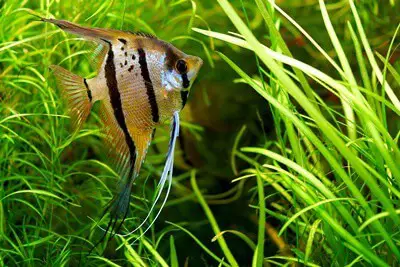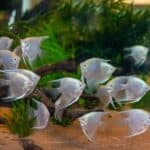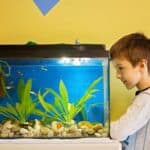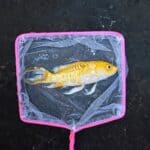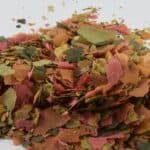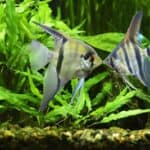Plants are an essential feature of an angelfish tank. Not only do they help to maintain the aquarium’s ecosystem, but angelfish love to swim in and out of plants for fun and enrichment.
The best plants for an angelfish tank include Anubias nana, Amazon sword, ambulia, java fern, hornwort, red tiger lotus, water sprite, water wisteria, and Vallisneria.
Plants are essential because they provide oxygen, absorb ammonia, add shelter, and provide mental stimulation. They also reduce algae growth and help to replicate an angelfish’s natural habit.
Angelfish sometimes like to rub their bodies on plants to relieve itchiness.
Choosing the right plants for an angelfish tank is essential. Plants require specific pH levels and water temperatures to survive, so not all are suitable for aquariums.
Do Angelfish Need Live Plants?
Live aquarium plants create a balanced ecosystem and keep the tank clean and chemical levels stable. Without plants, angelfish tanks are at risk of low oxygen levels and too much ammonia.
Plants also provide angelfish mental stimulation because they offer places to hide and play.
The main reasons why angelfish need live plants are as follows:
Produce Oxygen
As described by the U.S Geological Survey, dissolved oxygen is consumed through an angelfish’s gills. As a result, the tank must be suitably oxygenated.
Plants produce oxygen during the day and remove carbon dioxide from the water at night. They do this through photosynthesis to create food, releasing oxygen and consuming carbon dioxide.
Photosynthetic cells within the plant’s leaves and stems contain pigments that trap light, breaking it down into hydrogen and oxygen.
Hydrogen binds to carbon dioxide and oxygen and forms glucose, which gives plants energy.
The oxygen left over from the process is released into the water for fish to breathe. It’s also sometimes released into the atmosphere at the water’s surface.
Plants also use fish feces and uneaten food as their fertilizer, which helps to keep the tank’s water clean.
Reduce Ammonia Levels
As described by the Florida Department of Agriculture and Consumer Services, ammonia is formed from protein metabolism. It’s also the primary waste product of fish.
While ammonia is found in all tanks, too much is a problem.
Ammonia poisoning kills angelfish or causes long-term side effects, including:
- Infections.
- Blindness.
- Recurring sores.
- Compromised immune system.
- Difficulty breathing.
- Torn fins.
- Red eyes.
Live aquarium plants help keep ammonia and nitrite levels under control by absorbing their compounds. Ammonia is a food source for plants, which they absorb through their leaves and roots.
However, this process can only happen if the plants are in good condition.
Decaying or dead plants cause ammonia levels to rise. Maintaining good tank hygiene is the best way to keep plants alive, as is removing all decaying matter.
Provide Hiding Spots
You’ve probably discovered angelfish hiding behind plants.
They do that because they provide refuge from territorial fish. A lack of hiding spaces leaves angelfish vulnerable to attack from dominant fish within the tank.
It can also make them stressed. Signs of stress include:
- Gasping at the surface of the tank.
- Lack of appetite or refusal to eat.
- Disease, which is often characterized by red eyes and white spots on the fish’s body.
- Frantic swimming.
- Odd swimming patterns.
If you already have angelfish and are noticing stress symptoms, add more plants to the aquarium.
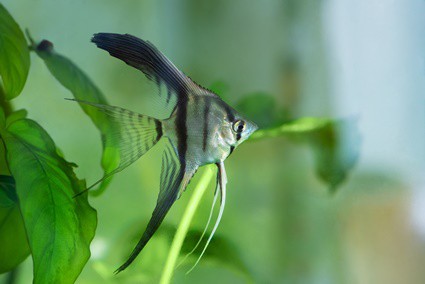
Allow Angelfish To Rub
If you’ve noticed the angelfish rubbing on plants, it’s likely because they’re using them to scratch. Most of the time, this is normal. However, rubbing against plants can also be a sign of:
- Parasites.
- Metals are present in new water.
- Ick.
- Gill flakes.
- Low water quality.
- Fluctuating pH levels.
- Sudden change in water temperature.
Therefore, plants are an excellent way to determine whether angelfish have a health issue.
Reduce Algae Growth
Algae appear in most tanks, but too much can be hazardous to angelfish. This is because it reduces the amount of dissolved oxygen in a tank and causes harmful ammonia spikes.
Algae overgrowth is caused by too much water, light, or nutrients. When they have these things in abundance, algae grow fast and cover the entire tank.
Because plants also need nutrients and light to grow, restricting them risks killing your plants.
Live aquarium plants absorb the same nutrients that cause algae to grow, resulting in less fuel for algae and preventing overgrowth.
Provide A Natural Environment
Angelfish are native to tropical South America, including the Amazon River system. In the wild, they prefer slow-moving water with overhanging vegetation and fallen trees.
As a result, providing a mixture of large and floating plants helps to replicate their natural environment.
As well as plants, adding pieces of driftwood into the tank replicates fallen trees, making angelfish feel comfortable in their captive environment.
Their body shape and patterns have also allowed them to blend into their surroundings, protecting them from predators. Grass-like plants are best for angelfish, as they protect them from other fish.
The ideal aquarium setup includes tall plants at the back and sides of the tank and a selection of small and large plants around the front and middle. This allows angelfish to dart in and out of the plants.
Best Aquarium Plants For Angelfish
All aquatic plants produce oxygen. As already mentioned, angelfish require plants that offer them places to hide from territorial fish.
By choosing plants similar to those found in the angelfish’s natural environment, you can create the optimum aquarium setup.
Incorporate some or all of these plants into your fish tank:
Anubias Nana
Anubias nana grows lower down than many other angelfish aquarium plants. As a result, it complements taller greens, like the Amazon sword, perfectly.
The plant tends to grow in width rather than height, protecting angelfish that like to bury into the substrate. Its growth rate is slow, and it doesn’t require much light, making it easy to care for.
As the leaves are thick and sturdy, they make a suitable place for angelfish to lay their eggs. They attract algae over time, but you can clean the leaves during a water change to prevent overgrowth.
You can plant Anubias nana in the substate or leave it to float. Either way, the plant will replicate natural Amazon conditions, providing a good home for angelfish.
If planting, place each two inches apart where they have light. It’s an excellent plant to have at the front of the aquarium.
Amazon Sword
Amazon sword is an excellent angelfish plant because it’s long and grows between 12-20 inches in the right conditions. Due to its height, angelfish can hide amongst it, finding shelter from other fish.
As it comes from the Amazon, it emulates angelfish’s natural conditions when added to their tank. It’s easy to care for and maintain, making it the perfect background plant.
Amazon sword is one of the best plants for breeding fish because angelfish lay their eggs on the blades of long-leaf plants.
If your tank is designed for breeding, plant an Amazon sword in the middle of the tank and add larger plants behind it at the back. This will keep the eggs protected from threats within the aquarium.
The Amazon sword needs 2-3 inches of substrate to grow, allowing for its large, broad leaves. It also grows well in temperatures ranging from 68-75°F.
It’ll grow slowly in low-light tanks and quickly with lots of light.
Ambulia
Ambulia is an iconic bushy stem that shares similar features with the hornwort plant. When planted in groups, it creates a dense hiding area that many angelfish enjoy resting in.
In low light, ambulia doesn’t grow very well. However, adding CO2 into the tank helps to give the plant a boost.
When kept in tanks with the right lighting conditions, ambulia grows fast. As a result, regular trims are needed to keep it under control.
Java Fern
Java fern is a popular aquarium plant for angelfish because it pairs well with driftwood. Java fern can’t be buried into the substrate, but you can tie it around driftwood or ornaments. Secure it with black cotton thread, and after a few weeks, the roots will attach to the object.
As a slow-growing plant, java fern grows to around 13 inches. There are narrow leaf and needle leaf varieties, which allow angelfish to swim and hide between the leaves.
Both varieties have a leathery appearance. They’re also hardy plants that can withstand plenty of activity within the aquarium.
Again, like most other angelfish-suitable plans, java fern is easy to care for. It only requires low to moderate light levels and grows well without additional nutrients or CO2.
The best tank conditions for java fern include a water temperature ranging from 68-82°F and a pH level between 6.0 and 7.5.
Hornwort
Hornwort is one of the tallest growing angelfish aquarium plants. It works well alongside the Amazon sword at the back of the tank, as it provides shelter and covers an angelfish’s eggs.
When planted in dense groups, angelfish search for cover amongst the stems. Hornwort is also an oxygenator, providing fish with a healthy natural oxygen supply.
As it grows fast, hornwort requires regular trimming to prevent it from covering the entire tank. It also needs moderate to bright lighting and a generous amount of liquid fertilizer to keep it healthy.
As well as the tank and fish benefits it provides, hornwort adds color to the aquarium. The leaves are primarily dark green, but in warmer tanks, light green hues occur.
Hygrophila
In their collective form, hygrophilais are known as swamp weeds. They thrive in shallow and warm conditions that are rich in organic matter. As a result, they’re highly compatible with angelfish.
Hygrophila is a good starter plant for newbie angelfish owners or people switching from plastic plants to live ones. While it thrives in light, it adapts to low-light conditions, growing slower.
Hygrophila has broad leaves that are ideal for sheltering angelfish. The leaves can grow up to 5 inches long, so they require regular preening.
Red Tiger Lotus
Red tiger lotus is also known as dwarf tiger lotus and dwarf tiger lily. It’s an African stagnant water plant with reddish-pink lily pads, adding color and excitement to fish tanks. It can also grow flowers.
Red tiger lotus provides shelter for angelfish, particularly for fish that prefer to be on the bottom of the tank.
It has a medium growth speed when the tank’s light is medium to strong. It can grow between 7-31 inches in height and 9-23 inches in width.
Similarly, the water’s temperature should be between 71-86°F for the plant to thrive. The ideal pH is between 6.0-8.0.
Regarding other plants in your angelfish tank, red tiger lotus is most compatible with Anubias nana, java fern, and winter wisteria. This is because they don’t compete with each other for nutrients.
Water Sprite
Water sprite, also known as water fern, is another excellent addition to an angelfish aquarium. Its long, narrow stems and leaves form a thick wall inside the tank that angelfish enjoy swimming through and hiding in. They can even lay their eggs on the leaves.
Reaching 13 inches in height, water sprite makes a suitable background plant. It’s also ideal for larger tanks that need an assortment of dense plants. While it grows tall, it grows slowly. It only requires a trim now and then to maintain a manageable height.
Water sprite thrives in the angelfish’s optimum conditions, suiting temperatures of 68-82°F and a pH level between 6.0 and 7.5. This makes it compatible with other aquarium plants, too.
If you have a breeding tank, combine water sprite with Amazon sword and hornwort for the optimum aquarium conditions.
Water Wisteria
Water wisteria is ideal for large angelfish aquariums with room to spare. It’s a rooted plant that requires planting into the substrate. As a result, a robust and good-quality substrate is needed.
Water wisteria reaches around 10 inches in width and 20 inches in height. While it’s best for larger tanks, you can trim it to a smaller size. Therefore, it works as both a background and mid-tank plant, depending on where you need it to go.
As a leafy plant, water wisteria provides hiding spaces for angelfish. They can also lay their eggs on the leaves. If you’re leaving it to grow tall as a background plant, angelfish can enjoy privacy from the whole plant.
Water wisteria is another good plant for adding color. It has bright green leaves and narrow, pointy protrusions. It needs a temperature ranging from 70-82°F and a pH level between 6.5-7.5 to survive. As a result, it’s compatible with other suitable angelfish plants.
Vallisneria
Vallisneria is low maintenance, cheap, and one of the most natural plants for angelfish aquariums.
All you need is a small branch, and it’ll quickly grow to be dense and luscious. Many angelfish prefer wide tanks that allow them to burrow into the substrate, so Vallisneria is ideal for wider aquariums.
Vallisneria prefers bright lights but can still grow in tanks with lower levels. It’ll merely grow slower. There are three different types of Vallisneria:
- Vallisneria spiralis, which is long and straight. It looks like tall blades of grass.
- Vallisneria Americana, which has long, thicker leaves. It’s also known as “jungle val.”
- Vallisneria asiatica, which has twisted spiral leaves.
Jungle val the best kind for angelfish because the stems grow tightly together, creating the ultimate playground for them.
It grows to 6.5 feet, so the plant needs regular trimming to prevent it from growing taller than the aquarium.
How To Switch From Plastic To Live Plants
The benefits of having live plants within your angelfish tank far outweigh the aesthetics of plastic plants. Not only that, but plastic plants fade quickly and harbor harmful bacteria and algae.
Switching from plastic to live plants is relatively straightforward. To do so, follow these steps:
Choose Your Plants
We’ve already delved into which plants are most suitable for angelfish, so the first step is to choose the ones you’d like in the tank.
It’s advised to have a mixture of plants of varying heights, sizes, and textures, but be careful not to overload your tank. Angelfish need space to swim around in the open.
Add Substrate
Chances are, you already have substrate in your tank. It might suit your chosen live plants, but you must double-check to ensure they can root into it. Some plants need up to three inches of a planted tank substrate to allow this.
Your chosen angelfish substrate, such as sand, can go on top.
Add Water
The water is now ready to go into the tank. Add enough for the water line to be four inches high to keep the plants sturdy.
As you add the water, try not to disturb the substrate. An excellent tip to combat this is to add an upturned Tupperware lid to the substrate, slowly adding the correct amount of water.
Add The Plants And Features
Before planting, add your decorations and ornaments to plant around them. It’s much easier to do it this way than attempting to add the plants afterward.
Most aquarium plants come in pots, so remove the pots and carefully detach the roots from them, being careful not to pull the roots off.
To plant, gently use your finger to create a small gap. Place the roots into the opening and cover them with the substrate. For small roots, you might find it easier to use tweezers. Let the plants grow and thrive, and add nutrients whenever needed.
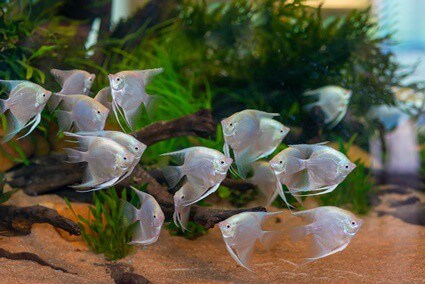
How To Provide The Right Environment For Aquatic Plants
Plants don’t have much control over the rate at which they photosynthesize. As a result, providing the right conditions within the tank is the best way to keep the plants working efficiently. It also prevents them from dying.
To keep your aquatic plants healthy, provide the following conditions:
Light
Plants can only photosynthesize when there’s an ample amount of light, allowing them to trap it within their cells.
Plants also only photosynthesize during the day when it’s light. At night, they stop. This is why you’ll sometimes find your angelfish gasping at the water’s surface at night or first thing in the morning.
Most wild tropical plants experience around 12 hours of sunlight each day. As a result, emulating natural conditions with 12 hours of light inside the tank is best to ensure a healthy ecosystem.
Keeping the light on for longer may lead to an overload of oxygen in the tank, which can suffocate fish. It may also cause the plants to work too hard, over-synthesizing, and die.
Temperature
You must keep your angelfish aquarium’s temperature between 78° and 84° F, as they prefer warmer waters. Plants inside the tank also do well at these temperatures, as it provides them with carbon dioxide and nutrients.
However, raising the temperature by only 18°F can cause plants to die, ending photosynthesis. As a result, angelfish are at risk of suffocation from a lack of natural oxygen.
To avoid issues, keep the tank at the same temperature and don’t allow it to become too warm.
Substrate
Plants inside an angelfish aquarium need a reliable substrate to anchor their roots.
Because cichlids like to dig, fine sand is best for plants and angelfish as it won’t cut or scratch their scales.
This is also why it’s essential to choose plants that thrive in a sandy substrate for the angelfish tank, as your fish’s welfare can’t be compromised for the plants.
Nutrients
Aquatic plants need the following minerals to grow:
- Nitrogen.
- Phosphorus.
- Potassium.
- Iron.
- Magnesium.
- Manganese.
While they get most of their nitrogen and phosphorus requirements from fish waste and uneaten food, you’ll need to add nutrients to the tank weekly or every few days to help the plants grow.
Plant nutrients are available as liquid or fertilizer tablets. Some plants also do well with a CO2 supplement. While this isn’t a requirement, it can help aquarium plants grow bigger and improve their color.
As long as the plants you choose are compatible with the water temperatures, substrate, and pH levels your angelfish needs, they can live inside the tank.
If the requirements don’t match, the plants will die and cause ammonia to rise to harmful levels.

